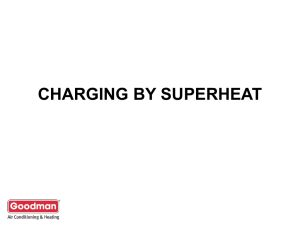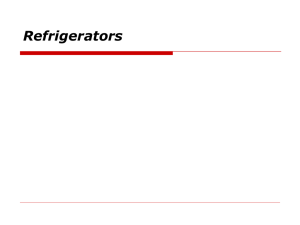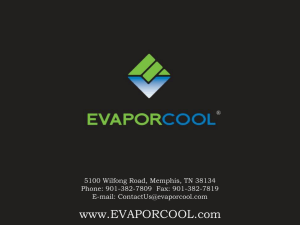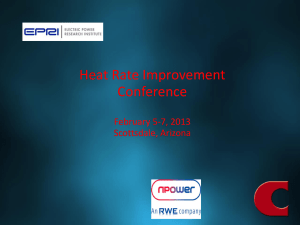HVACR415_L12_CondensorSubcooling
advertisement
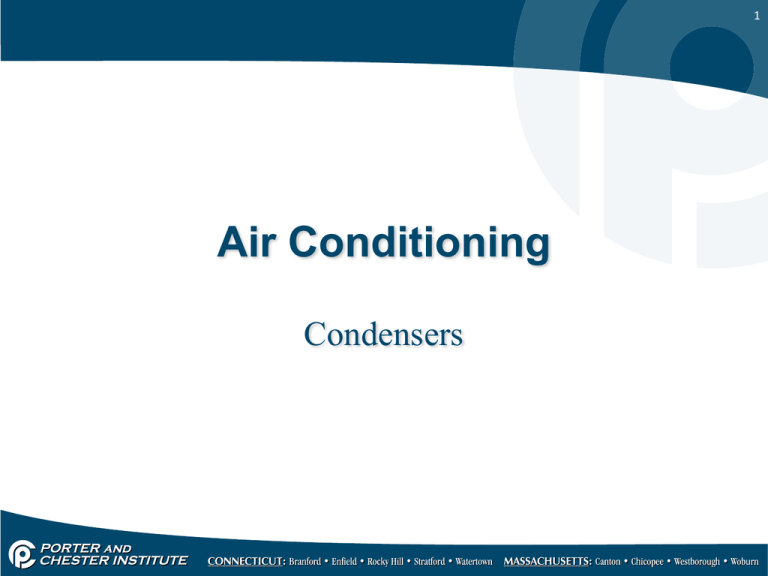
1 Air Conditioning Condensers 2 Types of Condensers • Two main types of condensers: – Water Cooled – Air Cooled 3 Air Cooled Condensers • Air conditioning primarily uses forced draft condensers • Use fans and blowers to move the air through a coil. • Fins are connected to condenser tubes to provide more surface area for heat transfer. 4 Air Cooled Condenser 5 Air Cooled Condenser 6 Air Cooled Condensers • The normal temperature difference between the condensing point of the refrigerant and the ambient air is 20 to 30 degrees F. • The condensing point of the refrigerant is found by converting the pressure in the condenser to temperature. 7 Air Cooled Condensers • Sub-cooling takes place in the last few passes of the condenser. – To measure sub-cooling use the condensing point temperature and subtract the temperature of the refrigerant leaving the condenser. – The temperature of the refrigerant is found by placing a clamp-on thermometer on the liquid line at the condenser outlet. 8 Subcooling 9 Water Cooled Condensers • There are three main types of water cooled condensers: – Tube-N-Tube – Shell-N-Tube – Shell-N-Coil Tube – N - Tube • A tube within a tube • The outer tube carries the refrigerant – This allows the refrigerant to be cooled by both water and air. • The inner tube carries the water. – The inner tube often has a fin spiraled around it to add surface area. 10 Tube – N - Tube 11 12 Shell - N - Tube • A large tube with a number of small tubes inside. • The refrigerant is again circulated around the water tube and cooled by the water and air. Shell – N - Tube 13 Shell – N - Tube • Both the tube-n-tube and shell-n-tube condensers can be cleaned by pushing or forcing a special brush through the water tubes or by using a chemical. 14 Shell – N - Coil • • • • A large shell or tank with a coil inside. Water is pumped through the coil. Refrigerant is outside in the tank. The refrigerant is cooled by both the air and the coil. 15 Shell – N - Coil 16 17 Water Regulating valves • Used with water cooled condensers to adjust the amount of water through the condenser maintaining the condensing pressure. • Water regulating valves are needed with condensers using “city water” (open loop). 18 Water Regulating Valves 19 Water Regulating Valves • A bellows on the valves is connected to a high pressure access port. • As the refrigerant pressure increases on the high side it pushes on the bellows and forces the valves open. • This allows more water to flow through the condenser. 20 Water Regulating Valves 21 Water Regulating Valves • As the head pressure decreases the pressure on the bellows decreases and allows a spring to push the valve closed. • This valve modulates to maintain the correct head pressure and reduces water consumption. 22 Water Regulating Valves • When the compressor stops the head pressure drops and the water regulating valve will close. • This prevents waste of the “street” or well water. 23 Water Towers • The other way to cool water cooled condensers is the use of a water tower or cooling tower. • This “tower” is used to cool water in the water cooled condensers. 24 Water Towers • The water used by the condenser is stored in the tower and pumped to the condenser when the system compressor runs. • The water returns to the top of the tower after absorbing heat from the refrigerant in the condenser. 25 Water Towers 26 Water Towers • The heated water falls through the tower over baffles cooling through evaporation as it gets to the bottom. • The cooled water collects in the sump (bottom) of the tower and gets pumped back to the condenser. 27 Water Towers 28 Water Towers 29 Water Towers • Fans are used to aid the tower and speed up the cooling. • The fans are controlled by the water temperature. • The ability of the tower to cool is based on outdoor wet bulb and humidity. • Water must be able to evaporate. 30 Water Towers 31 Evaporative Condensers • These look like water towers but the difference is that the condenser tubes are in the tower. • The water is pumped from the sump of the evaporative condenser and sprayed on the condenser tubes. 32 Evaporative Condenser 33 Evaporative Condensers • When the water hits the tubes it evaporates and cools the refrigerant inside the condenser tubes. • Fans are sometimes added to speed and aid the process. • The fans are controlled by the head pressure. 34 Water Treatment • Water used in the water towers and evaporative condensers can cause scaling and corrosion. • Scale is caused by the mineral concentration that increases as the water evaporates. 35 Water Treatment • The pH level also changes as the water evaporates. • Conductivity is a way of measuring the scaling potential and pH levels should be monitored. 36 Water Treatment • Chemicals can be added to adjust the pH levels. • Allowing some water to be dumped during operation causes fresh water to be constantly added by a make up water float and valve. 37 Water Treatment • This make up water flushes out some of the water and minerals. • This constant flushing aids in maintaining low mineral concentrations. 38 Subcooling Subcooling • What is subcooling? – A temperature of a liquid when it is cooled below its condensing temperature. – Subcooling is the sensible heat removed from the liquid after the change of state has taken place. – Subcooling is used to determine if the condenser has proper level of refrigerant. 39 Subcooling • The complete condensing of refrigerant should occur in the bottom quarter of the condenser. – Any heat that is removed after this point is subcooling. 40 Subcooling • Subcooling is needed to maintain proper system balance. • Normal subcooling is between 15-20 degrees F. – Depending on how efficient the condenser is subcooling may be a little higher or lower. 41 Subcooling – If the subcooling is low • Possible dirty condenser • Check condenser fan operation • Look for overcharged condition – If the subcooling is high • Low charge 42 subcooling 43 Subcooling • Subcooling can be accomplished by placing the liquid line and the suction line in direct contact with each other. • This is usually done in small or low temperature units. • This higher subcooling results in a more efficient unit. 44 Subcooling • The liquid in the liquid line will be cooled below its condensing temperature. – Also the suction line may be warmed slightly to boil any refrigerant which may be present before entering the compressor. • The lower the temperature in the liquid line, the greater the heat removal capacity. 45 Subcooling • This greater subcooling can also be achieved by one system cooling another so that the system can more efficiently reach lower temperatures. – This is known as a cascade system. • Cascade systems are usually required for ultra-low temperature operations. 46 Measuring Subcooling • Determine the condensing temperate. – Use your gauges and convert the high side. – This should be the ambient temperature plus 30-35 degrees for air cooled systems. • Measure the condenser outlet or the liquid line temperature. 47 Measuring Subcooling • Subtract the liquid line temperature from the condensing temperature. • The result is subcooling. 48 Subcooling Example 49 Common Accessories • Sight Glass: – Provides a way to see the refrigerant in the system. – Contains a strip that shows moisture in the system. – Do NOT charge with this as you should always charge with gauges. 50 Common Accessories • Filter Dryer: – Located on the liquid line and removes the moisture and/or debris from the system. – The drier material is made out of Silica gel or a molecular sieve which both filter and absorb moisture. – The liquid line filter should be replaced any time the system is opened. 51 Common Accessories • Filter Drier (cont) – Special cleanup driers and suction line “core type” driers are usually installed on systems that are badly contaminated. – Make sure you are aware of the direction of the arrow on filter driers. Most are not bidirectional. 52 Common Accessories • Suction line filter drier: – Provides additional cleanup on a system that has had a compressor burn out. It is placed on the suction line between the evaporator and the compressor. – Usually changed a few weeks after the compressor change out. 53
